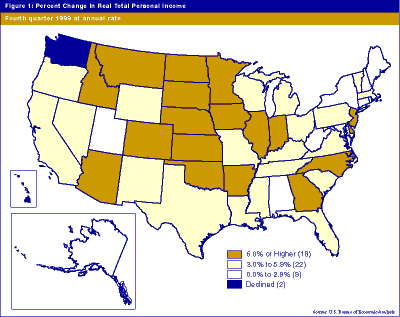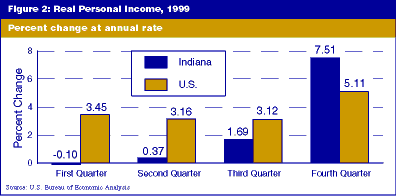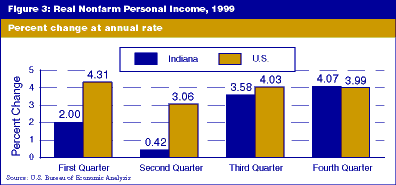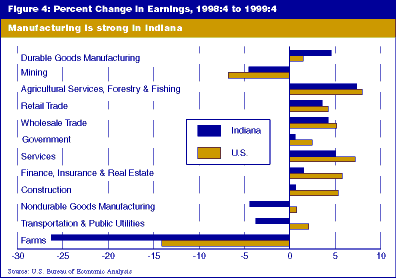Personal Income Growth Accelerated During 1999
Quarterly personal income figures released by the U.S. Department of Commerce show Indiana's economy advanced at a torrid 7.5% annual rate in the last quarter of 1999. The nation grew by 5.1% in the same period. Indiana's growth was 12th among the 50 states (see Figure 1).
Click on map to see larger version.

In the 40 quarters that made up the 1990s, Indiana had 35 periods of positive growth compared with 36 positive quarters for the nation. Utah, Oregon, New Mexico and Nevada led the nation with only one down quarter in the entire decade. Hawaii and North Dakota, by contrast, had only 25 positive quarters.
Over the entire decade, Indiana averaged a 2.95% growth rate compared with the nation's 3.02% average increase. This record put the Hoosier state in 27th place among the 50 states, just behind Illinois and Delaware and just ahead of Virginia and Massachusetts.
Perhaps the most volatile component of personal income is farm proprietors'
earnings. This residual tends to reflect swings in market conditions as well
as the irregular patterns of federal government subsidy payments. When nonfarm
earnings alone are considered, the story of Indiana's 1999 economy is somewhat
different.
Figure 2 shows that total real personal income in the Indiana economy (that
is, adjusted for inflation and including the farm sector) was flat in the
first quarter but came on strongly during the year to surpass the nation in
the fourth quarter. But when the farm sector—which accounts for less
than 1% of the total—is excluded, the results are very different.

In Figure 3, nonfarm personal income is more stable at both the state and national levels. But here Indiana's weak quarter is the second of the year, when the nation shows a slowdown in its growth rate. As the nation resumed a higher growth path in the last half of 1999, Indiana's economy responded with performance that approached and then exceeded the nation's.

This pattern of economic change is driven by the importance of durable-goods manufacturing in Indiana's economy. At the close of 1999, 22% of the income earned by Hoosiers (either through self-employment or working for others) originated in manufacturing of durable goods; nationally 10% of earnings are derived from that sector. Although durable-goods manufacturing did not lead Indiana's earnings growth (that honor went to agricultural services), it did provide Indiana's competitive advantage for 1999.
Figure 4 shows that the greatest positive difference between earnings growth in Indiana and in the nation was in the manufacture of durable goods. The largest negative difference (the bottom of the chart) was in farming. A careful examination of Figure 4 shows that, aside from mining, which had a decline in earnings, durable goods manufacturing provided Indiana with earnings growth greater than the national rate.

